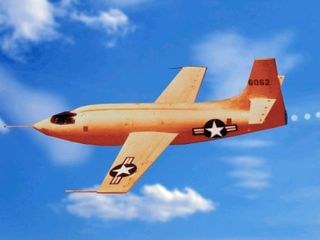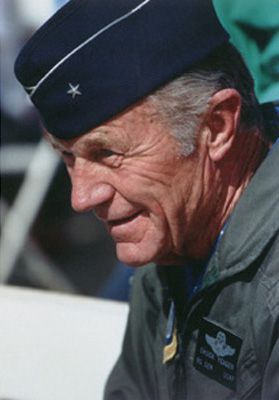Breaking the Sound Barrier | The Greatest Moments in Flight
This is part of a SPACE.com series of articles on the Greatest Moments in Flight, the breakthrough events that paved the way for human spaceflight and its next steps: asteroid mining and bases on the moon and Mars.
A booming thunder roared across the clear skies of the Mojave Desert on Oct. 14, 1947, as U.S. Air Force Capt. Chuck Yeager nudged an experimental rocket-powered plane faster than the speed of sound. Though only a handful of people realized it at the time, an aviation record had been set.
In 1935, a simplified explanation of the challenges of supersonic flight led to the creation of the term "sound barrier," which seemed to imply a physical wall that could not be overcome. Bullets and cannon balls had exceeded the speed of sound for hundreds of years, but the question loomed as to whether or not a plane — or a man — could withstand the pressures that accompanied it. The U.S. Air Force set out to answer this looming question.
The plane

Four rocket engines propelled the X-1, and it was built to absorb 18 times the force of gravity. Unlike most planes, it didn't take off from the ground, but was instead dropped from the belly of a B-29 Superfortress, rapidly accelerating in the air on only a few minutes worth of fuel before gliding back to the dry lakes below.
The plane, nicknamed the "Glamorous Glennis" for Yeager's wife, slowly approached the sound barrier over the course of nine flights. Muroc Air Force Base — now known as Edwards Air Force Base — in the empty southern California desert provided an ideal spot for testing a variety of experimental vehicles, including the X-1.
The pilot
The man who would become the most famous test pilot in American history was born in West Virginia on Feb. 13, 1923. Charles Elwood "Chuck" Yeager enlisted as a private in the U.S. Army Air Corps at the age of 18 and served in World War II, where he flew 64 combat missions.
Like many of his generation, Yeager enrolled in the military in 1941. In a 2017 interview with Forbes, Yeager said he was a gifted mechanic who had never seen an airplane before he turned 18.
"But I noticed that, as a mechanic, my hands were always greasy while the pilots' were clean — and they had good-looking girls on their arms. Flying looked pretty good to me," he told Forbes.
The military required a college education for its pilots, but when they didn't get enough applicants for the cadet flier program in 1942, they dropped the requirements to a high school diploma.
"With my visual acuity and understanding of mechanics, I was really a hell of a lot better than the cadets. From there on, I was in the right place at the right time," he told Forbes.
In 1945, he was assigned as a maintenance officer to the Flight Test Division at Wright Field, Ohio, flight-testing the planes. Col. Albert Boyd, in charge of the test program for the Air Force, invited him to become a test pilot, and Yeager accepted, transferring to Muroc to enroll in the Flight Performance School. It was there that Yeager was selected to be the first person to attempt to exceed the speed of sound.
The flight
Yeager's first test launch of the Glamorous Glennis took place on Aug. 29, 1947, with subsequent attempts increasing speed by two-hundredths of a Mach number. Mach is a unit of measuring the speed of sound in a given medium; a plane traveling at .2 Mach moves at only two-tenths the speed of sound, while Mach 1 is equal to it. (The speed of sound is about 758 mph or 1,220 km/h at sea level, and decreases with altitude.)
Reaching .86 Mach on the sixth flight, the X-1 began to experience turbulence from the shock wave formed by the compression of the air. On the seventh flight, at Mach .94, Yeager lost the ability to control the plane's elevator, which was a problem because the shock waves caused the nose to pitch up and down. He cut the engines, dumped the fuel, and landed safely in the desert. Another pilot suggested using the horizontal stabilizer to correct the problem, and on-the-ground tests seemed to suggest the alternate method of control would work.
Two days before his historic flight, Yeager was thrown from a horse while riding with his wife and broke two ribs. Knowing that he would never be allowed to fly, he traveled to a doctor off base and had them taped up. Unable to close and latch the side door by hand, he utilized a broom handle at the suggestion of a fellow pilot.
On Oct. 14, 1947, Yeager and the X-1 were dropped from the B-29, and quickly accelerated away. When the controls locked up, he successfully used the horizontal stabilizer to keep the plane stable at an altitude of 43,000 feet (13,000 meters). As the plane accelerated to a speed of 700 mph (1,127 km/h), or Mach 1.06, controllers on the ground heard the first sonic boom. (The end of a bullwhip moves faster than the speed of sound. Some say the "crack" is a small sonic boom.)
After exceeding the speed of sound, the buffeting decreased, creating a smooth short flight. The plane remained supersonic for approximately 20 seconds before Yeager turned off two of the four engines and slowly decelerated.

The follow-up
Yeager continued to fly experimental aircraft for the Air Force, and was appointed director of the Space School, NASA's precursor, where he trained astronauts to prepare for launch. He flew more than 120 combat missions in Vietnam. After 34 years in the military, he retired in 1975 at the rank of brigadier general, though he continued to serve as a consultant. His last flight as a military consultant occurred 50 years to the day after he broke the sound barrier, at the age of 74.
According to This Day in Aviation, he told the crowd, "All that I am…I owe to the Air Force."
In 1979, Tom Wolfe's best-selling nonfiction book, "The Right Stuff," and the subsequent 1983 movie popularized Yeager's exploits to a generation too young to remember them.
Yeager and his wife, Glennis, had four children before her death in 1990. He remarried in 2003.
Supersonic research
In the meantime, research continued on supersonic flight. By 1959, the X-15 would travel five times faster than the speed of sound, paving the way toward human space flight. The 1990s saw the launch of the High-Speed Research Program, a NASA-industry collaboration to develop a concept for the next-generation supersonic passenger jet. Engineers envisioned it carrying 300 passengers at more than 1,500 mph (2,414 km/h).
"Although phased out in 1999 because of economic constraints, the HSR effort set new standards in concepts for propulsion systems, materials and structures, cockpit controls, and assessment of environmental impacts," NASA said in a statement.
In 2016, Langley announced that it was collaborating with Lockheed Martin to assess quiet supersonic technology as part of NASA's latest X-plane initiative New Aviation Horizons.
"We're at the right place, at the right time, with the right technologies," Jaiwon Shin, associate administrator for NASA's Aeronautics Research Mission Directorate, said in a statement. "We need the X-planes to prove, in an undeniable way, how that tech can make aviation more Earth friendly, reduce delays and maintain safety for the flying public, and support an industry that's critical to our nation's economic vitality."
Related:
The Greatest Moments in Flight
- The First Hot-Air Balloon
- The First Powered Airship
- The Wright Brothers & the First Flight
- World's First Commercial Airline
- Charles Lindbergh & the First Solo Transatlantic Flight
The Most Amazing Flying Machines Ever
- The First Airplane: Wright Flyer
- The Red Baron & Aerial Weapons of World War I
- The Zeppelin Hindenburg: When Airships Ruled
- The First Fighter Jet: Me 262 Schwalbe
- SR-71 Blackbird: Supersonic Spy Aircraft
- Saturn V Rocket & Apollo Spacecraft
Image galleries:
Join our Space Forums to keep talking space on the latest missions, night sky and more! And if you have a news tip, correction or comment, let us know at: community@space.com.
Get the Space.com Newsletter
Breaking space news, the latest updates on rocket launches, skywatching events and more!

Nola Taylor Tillman is a contributing writer for Space.com. She loves all things space and astronomy-related, and enjoys the opportunity to learn more. She has a Bachelor’s degree in English and Astrophysics from Agnes Scott college and served as an intern at Sky & Telescope magazine. In her free time, she homeschools her four children. Follow her on Twitter at @NolaTRedd